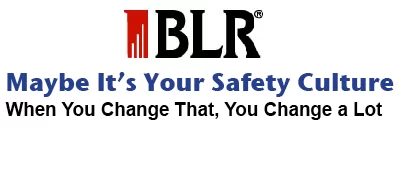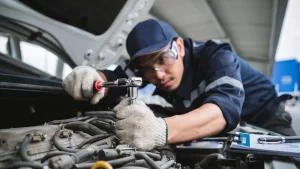When You Change It, You Change a Lot
Consultant Steven Simon recalls one enthusiastic employer who stated excitedly after attending a seminar on safety culture, "I like this culture change stuff. I want it in by Monday!" Not gonna happen, says Simon, a clinical psychologist who has been applying the principles of organizational culture to safety with impressive results for the past two decades. Simon has led top companies like International Paper, Toyota, United Technologies, General Foods, and Exxon through a process that can take years to establish fully, but whose rewards are worth the wait, say those who use it.
It's not a program, and it's certainly not a flavor-of-the-month, Simon emphasizes. What then is culture change? How is it different from behavioral approach-es? And what does it take to achieve results? Those are among questions answered in this Compliance Report.
Check your Broth
Simon wrote his doctoral dissertation on culture and became interested in its impact on organizational deci-sion-making. A friend in the safety incentive business shared with him a client's concern that incentives were not contributing to safety improvement. This came as no surprise to Simon, who helped the employer make cultural changes that led to a decline in injuries. This marked the beginning of the business now known as Culture Change Consultants, with Simon as president.
He and a staff of about six travel the country helping workplaces understand and create change. They also deliver seminars and publish books and articles.
Asked to explain safety culture, Simon jumps to the analogy of a stew. He says the basic elements of any stew are the meat and vegetables, which he equates to essential safety program elements such as training and equipment. The culture is the broth, and no matter how excellent the meat and vegetables, no stew can survive a "rancid broth." What are the elements that can spoil a workplace culture and undermine safety? Everything from mistrust between managers and workers, to a perception that managers don't care and a lack of opportunity for employee involvement.
Formally, Simon defines culture as "a set of basic assumptions and beliefs about reality itself.
These
beliefs influence the decisions we make, how we think, how we feel, and how we act." He also offers an informal definition: "Culture is what happens when no one is watching." For example, will an employee avoid wearing protective eyewear if he can get away with it?
Or do workers politely remind a visitor even a big boss in town from corporate headquarters —that nobody is allowed on the plant floor without safety glasses?
Therein lies the difference, he states.
It's Not Behavioral
Simon takes pains to articulate the differences between his approach and behavioral-based safety. "My view is that behavioral change without culture changes doesn't last. If you send people to no-smoking camp for two weeks to modify behavior, they will stop smoking. But once they return to work and home, where they smoked in the past, they will start up again." Actions-whether it's buckling a seatbelt or following safety protocols-are guided by group norms, which are influenced by assumptions or beliefs. Simon recalls an old Candid Camera episode in which a man enters an elevator where all the other riders are facing the back although the cle-vator has no back door. He enters and immediately turns around as well.
Similarly, workers can attend training and learn the policies of their workplace, but "everything can go out the window" when they are placed in a daily environment in which the lessons are not heeded. "Focusing on culture rather than on behavior means focusing on the norms of the work group, not on the behavior of the individual," Simon adds.
He does not believe in the theory that if employees merely observe one another and provide feedback (the essence of the behavioral method), they will change their behavior. The culture-based approach starts with the organization and works to impact the individual.
Simon does note that some businesses that have successfully implemented his culture change model have subsequently added a behavioral component. This can work well, he acknowledges, but only in that order, and only once the culture has been altered.
Six Steps
Despite his fondness for the "stew" analogy, Simon emphasizes that there's no single recipe for cooking up culture change. Workplaces vary greatly and the process to change their culture must reflect those dif-ferences. He describes the basic steps involved, with the caveat that they are not set in stone, but rather serve as guideposts:
- Make the Case for Change.
This includes understanding the barriers to improved performance that lie within a workplace's existing culture. An example would be mistrust and a lack of success with past methods attempted.
- Establish the vision.
An organization needs to determine what type of safety culture would succeed best. For example, at a pipeline operation, the culture should emphasize the notion of personnel watching out for one another. (It's not uncommon on a pipeline for two employees to work on a task miles from other crew members.
- Assess the current culture.
"Asking members of the tribe is the best way to learn about the tribe," quips Simon. He uses surveys and focus groups.
- Develop a strategic plan.
This includes understanding the barriers to improved performance that lie within a workplace's existing culture. An example would be mistrust and a lack of success with past methods attempted.
- Use teams (grassroots and leadership) to implement the plan.
Simon offers a number of tools to help employees take steps toward change.
- Monitor and make course corrections.
Nurturing a culture is akin to raising a child, Simon believes. The idea is to develop habits and tools so that it can sustain itself over time.
Driving Culture Change at GM
Simon recalls that when he was first called in to assist General Motors (GM) in the 1990s, corporate managers had the habit of calling the various plants every Monday morning to ask two questions. One was the number of vehicles produced the prior week, and the other was the results of a quality audit. The fact that no one was asking how safely the work had been performed spoke volumes to Simon.
In the intervening decade, Simon has led a worldwide culture change process at GM. He explains that GM was like many companies at which a CEO or plant manager perceives a problem with the culture of the organization and calls for change. The impetus can also come from employees or from a safety professional or other "champion." Before Simon came on board, GM had exchanged benchmarking teams with Alcoa, a company with a world-class safety record. The Alcoa team reported that GM had exceptional programs— "four-color training brochures and excellent audit sys-tems." But the automaker lacked a safety culture to sustain those programs.
Recognizing that the company had a top-down management style, GM decided leadership had to be the first to change. Simon constructed a full-day leadership workshop for senior manufacturing managers that helped "asses and transform their role and behavior in the safety process." The managers charactered a series of short-term culture transition teams, each didicated to a particular aspect of the overall change process.
Energizing GE
At other businesses, culture change is driven by a safety and health professional turned change agent. That was the case at a General Electric (GE) steam turbine manufacturing plant in Fitchburg, Massachusetts, where the prevailing mentality was that productivity was more important than safety. Mark Leik [pro-nounced "Like"] is current manager of EHS for GE Nuclear Energy in San Jose, California. Leik had met Steve Simon several years earlier when he was with a different GE division. Leik questioned the value of culture change and frankly, "wondered who would fall for this kind of magic and mystery."
Add It Up!
Steven Simon, president of Culture Change Consultants, has helped businesses realize lasting benefits in safety and beyond over the past 20 years. Lest anyone believe that culture change is a "soft" initiative that makes people feel better but doesn't reduce injuries, Simon offers the following sampling of results:- GM worldwide reduced total recordable rates by 77 percent and lost-time injury rates by 89 percent since 1994.
- At GE's steam turbine manufacturing plant in Fitchburg, Massachusetts, accident rates dropped 76 percent between 1994 and 1998.
- At Lawrence Livermore National Laboratories, the skilled trades group slashed job injuries by 80 percent and saved some $3 million since embarking on a safety improvement process in 1990.
Simon also cites gains in quality, productivity, and the "unqualifiables like teamwork, union-management relations, and healthier norms."
While working at a GE site in Los Angeles, Leik remembered Simon and, despite his initial skepticism, contacted him to help address significant safety problems there. The results were excellent. He thought the same strategy might work in Fitchburg, where he was brought in to help plant leaders struggling with safety. The site, which employed about 650 people, had an unenviable track record in safety. OSHA-recordable incident rates were high and, despite improvement efforts, those figures went largely unchanged for several years.
"We realized we were in some pretty serious problems in terms of culture," Leik recalled. "The workforce
and management didn't communicate.
Everybody spent time blaming rather than taking responsibility for their own actions. It was a really dysfunctional climate with a lot of hostility and anger."
Leik and a regional manager met with Simon and, working closely with employees and labor leaders, presented a plan for change. Fortunately, safety was not a hard sell at GE, a company that had been succeeding in reducing its overall accident rates, and which today. boasts one of the highest numbers of Voluntary Protection Program sites of any company. According to Simon and Leik, who have written about the Fitchburg experience. "The key was gaining the support of plant employees, who would eventually take control of the initiative. This meant ircluding nearly everyone because culture change requires an integrated approach with participation by all levels of the organization."
As catalyst for the process, Leik took several key steps. He: (1) built coalitions among representative groups in the plant, (2) communicated a persuasive vision that unified them, and (3) took a leadership role; teaching the basics of culture-based safety to others.
What Changed
Unlike a behavioral-based process where one can count observations and tally other types of interactions, culture-change activities involve other types of strate-gy. Leik describes a number of those employed at the Fitchburg site. Perhaps the most important was the team approach—a Simon essential.
The existing safety committee was replaced by a set of teams with much broader participation. These empowered teams led the changes process. Grassroots teams led the change process. Grassroots teams were established for manufacturing and ergonomics. A leadership team was comprised of union leaders, supervisors, and plant managers. The teams were trained in relevant safety regulations, communica-tions, priority-setting, and management of their own budgets. The grassroots teams gave workers on the plant floor an easy way to express ideas and concerns. The teams eventually took over much of the safety func-tion, making decisions about training and even about the funding of safety programs. Management allowed members the time needed to participate in team meetings and activities.
Among other strategic efforts:
- A validated survey was conducted to gather percep-tions, and copies of a final report were made available to all employees.
- Focus groups were conducted to assess the organizational culture and to determine what needed to change. Workers and managers met separately to encourage a full and open exchange.
- A set of organizational values was established. This helped both workers and managers articulate what mattered most to them.
- A cross-functional group of about 35 employees attended a one-day culture change workshop to learn Simon's approach.
- Several "transformational leaders" were identified from the rank-and-file. Leik describes these as people willing to take responsibility for what happens and injecting their energy into the process. He sees this as a hallmark of the culture change process; without these leaders the change will probably not occur.
- Weekly safety audits were conducted by two team members—a foreman, and a steward.
A New Attitude
It didn't take long for employees to begin to notice changes at the Fitchburg plant. Sylvia, a veteran forklift driver, got involved once she realized that the desires of labor and line workers were not very different from one another. She was also inspired when she saw how deeply involved the plant manager became in the process. "If she was so gung-ho, I wanted to be part of it," Sylvia told Simon, adding: "Before, there were many accidents, but people weren't aware of what was happening. After ... if there was an accident, we knew everything about it right away. What happened, how, and what was being done about it."
A safety communications center contributed to a more open atmosphere at the plant. It housed copies of relevant regulations, safcty manuals, meeting minutes, and charts depicting incident rates. The center was located on the shop floor, easily accessible to all employees. Another important change was recognition for participants in the culture change. Stories about their contri-butions, accompanied by photos, appeared on bulletin boards and in an EHS newsletter. Leik believes strongly in recognition without reward. He scoffs at the idea of giving people "another flashlight, preferring a more meaningful way of showing appreciation.
Workers on-site reported significant changes such as a positive attitude, based on understanding the risk, about wearing safety glasses. Under employee leader-ship, new safety equipment was purchased and the ventilation system was overhauled. Simon believes these changes meant far more to workers because of their direct involvement in bringing them about. Another more subtle change was an end to the finger-pointing that had plagued the plant in the past. Especially significant was a dramatic drop in accidents over a four-year period that coincided with the implementation of culture change. There was an even sharper decline in the facility's lost workday case rate.
Two years after the initial attitude survey was con-ducted, a follow-up study indicated that both managers and workers believed there had been major gains in several areas, including making information about safety available to employees and improved communication in general. Despite the gains, labor continued to see more opportunities for improvement than management.
According to Leik, the changes have become deeply ingrained into the workforce.
The culture change is
solid, he says, and remains in place even as managers and employees come and go. Leik also praised the relatively low cost of the process. He reiterates the importance of identifying and encouraging champions who will take the culture-change ball and run with it, influencing everyone in their midst.






